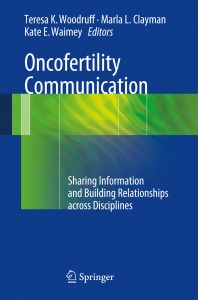 Oncofertility Communication: Sharing Information and Building Relationships across Disciplines devoted an entire chapter to the communication strategies and issues faced by oncology providers. Chapter 10 is entitled Fertility Communication to Cancer Patients: A Hematologist-Oncologist’s Perspective and is authored by Sara Barnato Giordano. As cancer treatments have advanced, the percentage of survivors continue to grow. Today, approximately 80% of adolescents and young adults given a cancer diagnosis will survive and be faced with a new set of challenges as long-term survivors. Many studies have shown that young women have a number of concerns related to sexual health, infertility and menopausal symptoms and there is significant room for improvement in communication and counseling in this patient group.
Oncofertility Communication: Sharing Information and Building Relationships across Disciplines devoted an entire chapter to the communication strategies and issues faced by oncology providers. Chapter 10 is entitled Fertility Communication to Cancer Patients: A Hematologist-Oncologist’s Perspective and is authored by Sara Barnato Giordano. As cancer treatments have advanced, the percentage of survivors continue to grow. Today, approximately 80% of adolescents and young adults given a cancer diagnosis will survive and be faced with a new set of challenges as long-term survivors. Many studies have shown that young women have a number of concerns related to sexual health, infertility and menopausal symptoms and there is significant room for improvement in communication and counseling in this patient group.
The American Society of Clinical Oncology (ASCO) released guidelines in 2006 that suggested that oncologists should address the possibility of infertility with patients treated during their reproductive years and be prepared to discuss possible fertility preservation options. They followed up these guidelines with a program, Quality Oncology Practice Initiative (QOPI) that established age-based parameters to provide guidance to oncologists when selecting available fertility preservation options to discuss with patients. Surveys have indicated that oncologists are often wary of referring patients for fertility preservation consultation for fear of delaying treatment too long or assuming that their patients would not be interested in discussing fertility. The ASCO guidelines were meant to be an impetus for implementing stronger fertility preservation programs but significant barriers still exist.
The author describes categories of barriers: health care system barriers, physician barriers, communication barriers, adolescent and young adult barriers, and parent barriers. Each present their own set of unique challenges. Health care system barriers demonstrate that while national guidelines have been disseminated and accepted, hospitals do not have procedures or policies in place that enforce the implementation of guidelines or designate which health care provider (physician, nurse, patient navigator, etc) are responsible for initiating the discussion. This leads into the next barrier: physician barriers. Physicians are often reluctant to endorse fertility preservation as they feel discussing infertility and fertility preservation options are neither appropriate nor an immediate clinical priority in light of a cancer diagnosis. Beyond that, physicians are tasked with providing a large amount of information to patients in a short amount of time after their cancer diagnosis which is where the communication barrier is most evident. Patients are flooded with information relating to diagnosis, treatment, side effects, and outcomes and the discussion of fertility preservation is often considered a lower priority. In addition, adolescent and young adult barriers and parent barriers are often intertwined throughout the course of cancer diagnosis and discussion. Discussion about fertility, such as sperm banking and ovarian stimulation, can be uncomfortable for adolescents or young adults and the process for fertility preservation can seem daunting in the face of a cancer diagnosis. Parental barriers often relate to lack of knowledge about the emotional development and cognitive process of their child as well as varying religious or cultural values of the family. Occasionally, the patient and the parent are at odds in their decisions and many physicians lack the tools necessary to effectively navigate the conversation.
With greater publicity around fertility preservation for cancer patients, more patients and parents are becoming their own advocate and requesting information and services for fertility preservation even if their physician does not offer it. However, the responsibility for conveying information about fertility preservation to patients lies in the hands of the medical professionals. The ASCO Guidelines and subsequent QOPI measures are mechanisms to improve communication and ease the referral process. New methods of communication strategies between physicians, parents, and patients must be identified and assessed and applicable training should be available to medial professionals on how to discuss fertility preservation with patients and their families.
Discuss communication strategies and troubleshoot barriers within your own home institution and refer back to Chapter 10, Fertility Communication to Cancer Patients: A Hematologist-Oncologist’s Perspective for talking points and references. Additional resources can be found on the Online Resources section or Patient Resources section of the Oncofertility Consortium website


 By: Brigid Martz Smith -
By: Brigid Martz Smith -